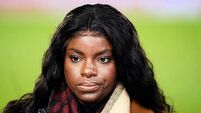When a real woman’s place was ... After Eight
DINNER parties were sophisticated when After Eights chocolates first appeared 50 years ago, in Feb, 1963. The thin mint fondants were marketed as a glamorous accessory for social occasions when the grim, conservative ’50s were being replaced by aspirational affluence. After Eights ads of the early ’60s featured immaculately dressed ladies, dripping pearls and diamond earrings.
“A woman’s place is in the home, eating After Eights and looking beautiful,” was the slogan for one. The ‘smart casual’ dress ethos of 2013 was a definite no-no in those halycon days of black tie and long frocks. “After Eight wafer-thin mints have the same effect on me as camellias and candlelight; they make me feel expensive, pampered and gay,” wittered one precious pet, biting another sinful square.
With membership of the fledgling EU (then EEC) a constant news feature of the late ‘60s, ad campaigns had their own angle on this dinner table topic: “Will joining the Common Market mean we’ll be able to get delicious Apres Huit, Nach Acht and Doppo le Otte wherever we go?” enquired a blonde of her male companion. Debt was an issue even then: another ad showed a tweed-wearing lady monitoring her household accounts as a Golden Retriever dozed at her feet: “Something has gone wrong with my balance of payments,” she whispers. “Do you think the butcher would take some After Eights in lieu?” Manufacturer Rowntree favoured the traditional view of women as housewives and homemakers in their ad campaigns — dressed glam and unbothered by business, politics or current affairs. Tongue in cheek, they were ‘ladies who lunch’ — and not women interested in challenging for equality in the boardroom.
One famous ad showed two 20something girls on a sofa, one dressed in twin-set and pearls, the other wearing spectacles, a dowdy pantsuit and reading The New Statesman. “Of course, nobody buys you After Eights, you’re liberated,” says one, waiting for the phone to ring with the expected offer of a date. While they may have ignored political correctness in their marketing, After Eights have sold more than a billion boxes of chocolates.
Dialling back to 1950s ads, women are more glamorous, and especially for Black Magic — dressing for dinner, attending the opera and confiding their innermost desires to their diaries. One lady gushes: “We silly creatures are always so thrilled when a man thinks us worth the best,” as she plucks another choccie from that tell-tale black box.
In a Milk Tray ad, a man in a public phonebox is on a call, arguing. Clearly in the wrong and in need of a peace offering, the man hangs up the receiver and turns sheepishly to the camera, saying of the chocolates, “lucky, I’ve got these”. In the final frame, all is forgiven as the lady gratefully clutches her apology gift, while he winks leeringly over her shoulder. Another ad, pushing a similar message, had the familiar slogan: “When you get a box of Roses, you’ve got yourself a man”.
The seductive Flake commercials plugged neatly into the ‘swinging 1960s’. One showed a woman ever so slowly nibbling the chocolate while relaxing in a bath. As the camera pulls back, we see the bath water overflowing all over the floor, as the woman, uncaring, is lost in ecstasy. For a product that was launched in the 1920s, those ads, starring model Holma McDonald, became master classes in the sensual art. One of the earliest, and most innocent, Flake ads had a girl relaxing in a boat being pestered by a nosy swan for a bite of her bar, followed, a year later, by an artist painting a field of poppy flowers. She pauses for a Flake break, unperturbed by a sudden summer shower.
In the 1980s, the seductive heat went up a few notches with a woman dressed only in a flimsy, silk negligee reclining on New York fire escape on a sultry summer night, indulging in a Flake bar as her ringing phone is ignored in the background. Pushing the theme further, a 1999 ad revealed a Parisian girl unwrapping a Flake while gazing transfixed at the Eiffel Tower in the distance. As she slowly bites into the bar, the garden sprinklers erupt, drenching her in water.
If the Flake girl became famous as a symbol of indulgence and secret pleasure, the slogan and jingles were immortalised: “Only the crumbliest, flakiest chocolate, tastes like chocolate never tasted before.” Given the possible phallic symbolism of the Flake, complaints from the public saw the ads scrapped in 2004.
While sexy ladies in suggestive poses have always been part of chocolate advertising, one of the most effective needed neither flimsy undies nor wanton expressions. A 2007 Dairy Milk ad features a gorilla in close-up gently moving to the drifting strains of the Phil Collins song, ‘In The Air Tonight’.
Slowly, the camera pulls back from the creature’s face as the music builds to a crescendo.
Then, to our surprise, the camera pans back to reveal him sitting behind a drum kit, whereupon he launches into a drum solo, juggling those sticks with an expertise even the late great, John Bonham or Keith Moon could only applaud. As an exercise in effective marketing, it ranks up there with the greatest.











